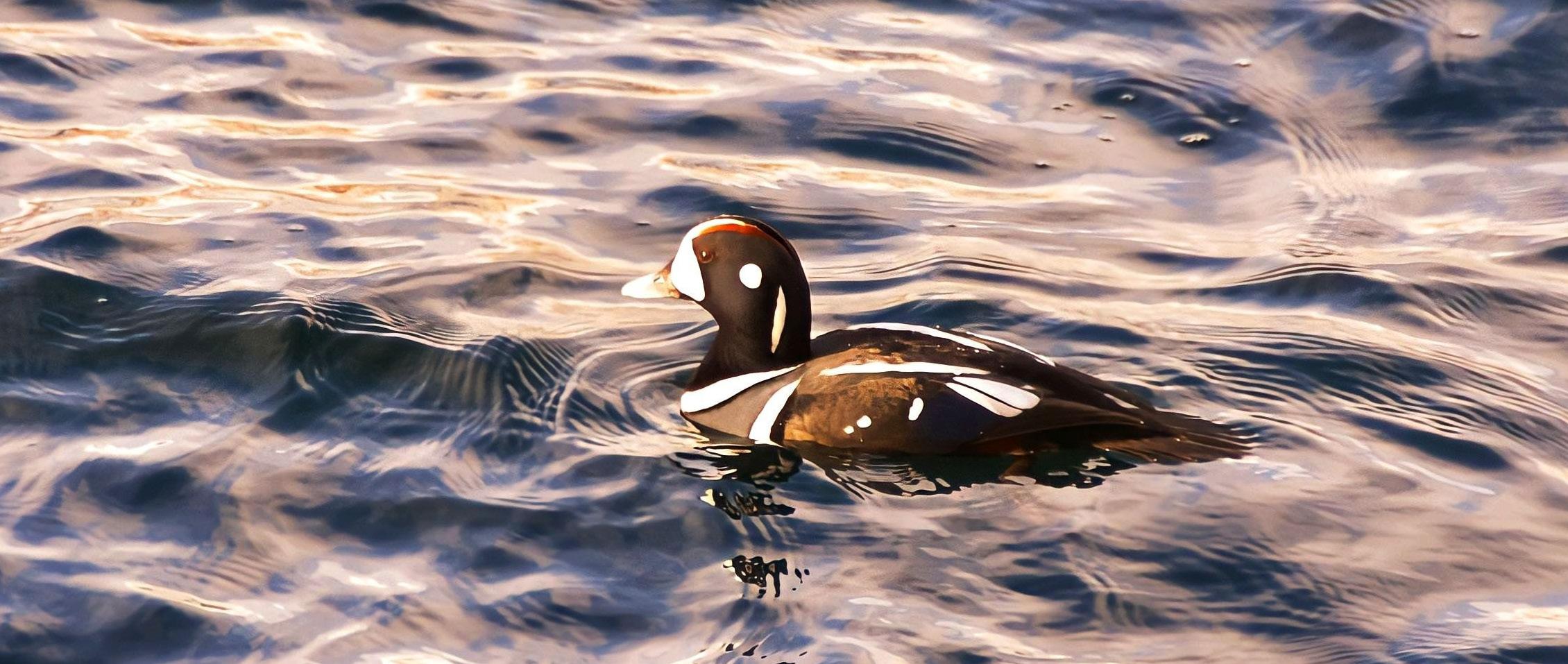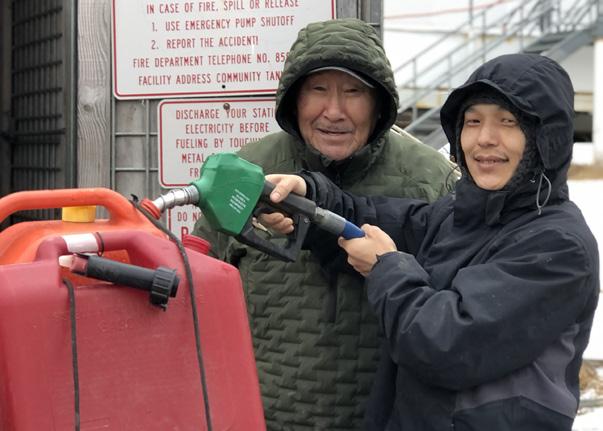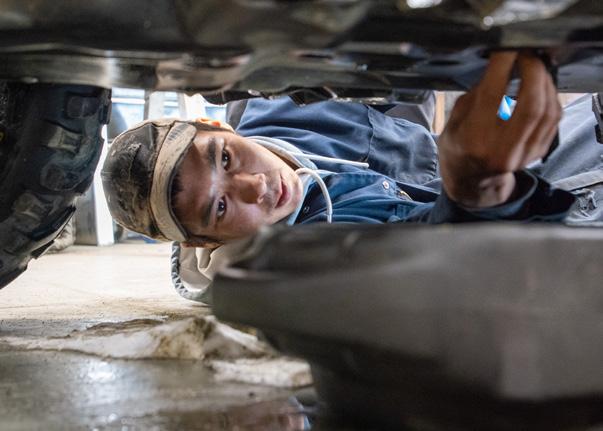
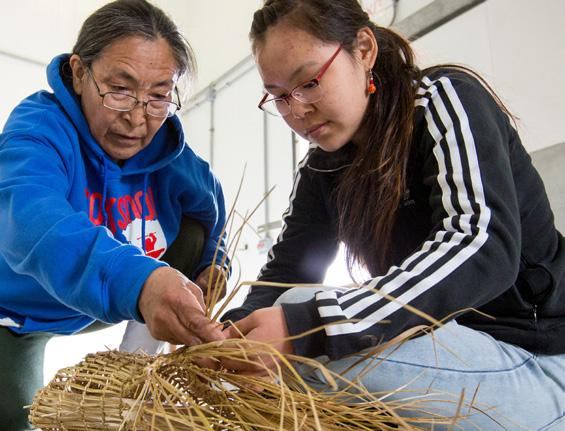
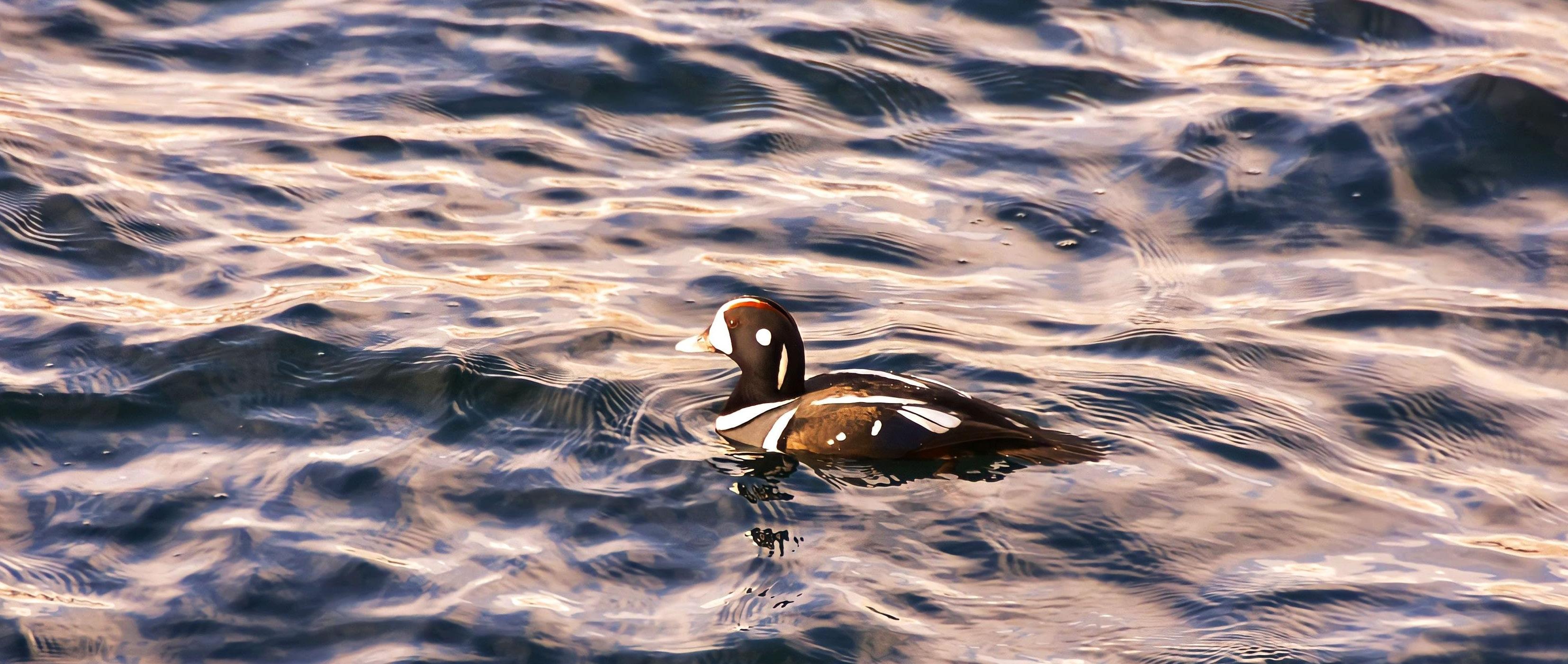












OUR VISION
To develop thriving local economies in Western Alaska that create opportunities for current and future generations.
OUR MISSION
To be responsible stewards of all our resources; to proactively identify and pursue investments that develop those resources; and to deliver value to our communities and people.
OUR CORE VALUES
• Effective Strategic Leadership
• Trust, Integrity and Teamwork
• Respect for and Understanding of All People
• Active Community Participation
• Respect for and Understanding of the Land, Sea and Resources
• Growth and Sustainability Through Maximum Return on Capital
• Industrious People + Job Opportunities = Self-determination
Scammon Bay
Hooper Bay
Chevak
Newtok/Mertarvik
Tununak Toksook Bay
Kipnuk
ALASKA
OUR CORE COMPETENCIES
• Balance the needs, wants and expectations of all — now and seven generations from now.
• Understand risks/rewards, develop a plan of action, support it and execute on it.
• Deliver efficient and equitable economic benefits to our communities.
• Develop and deploy successful business models and adapt as needed for future use.
• Support bold thinking and continuous innovation.
• Deliver disciplined, purposeful and sensible initiatives to sustain and stimulate new economic growth in our region.
OUR MEMBER COMMUNITIES
Goodnews Bay Platinum Mekoryuk
Tuntutuliak
Quinhagak Eek Kongiganak Napakiak Oscarville Nightmute Kwigillingok Chefornak
Napaskiak
• Scammon Bay
• Hooper Bay
• Chevak
• Newtok/ Mertarvik
• Tununak
• Mekoryuk
• Toksook Bay
• Nightmute
• Chefornak
• Kipnuk
• Kwigillingok
• Kongiganak
• Tuntutuliak
• Napakiak
• Napaskiak
• Oscarville
• Eek
• Quinhagak
• Goodnews Bay
• Platinum
Global seafood markets hit a historic low early in 2024, but our biggest challenge was right here at home: finding a safe space to tell CVRF’s positive story. There was good news to share by the end of the year, including stabilizing markets, steady delivery of popular programs like People Propel ® and new job training opportunities. We saw more residents working on our vessels and our salmon bycatch at sea remained very low. But for Alaskans who spend a lot of time on social media, the truth has become harder to find amidst an onslaught of negative, misleading misinformation about the Bering Sea. Psychologists call this phenomenon the “Illusion of Truth” if you repeat a lie over and over, people slowly assume it’s true.
For more than 30 years, the CDQ program has delivered critical benefits, creating jobs and leveraging infrastructure investments across Western Alaska. Like the Trans-Alaska pipeline does for the State of Alaska, CDQ delivers an economic lifeline to the rural, western communities of our isolated region. Unfortunately, CDQ and commercial fishing are fighting an Illusion of Truth on social media today, led by some of the same outside environmental groups that want Alaska to be their private playground, free of natural resource industries and without the quality of life made possible by modern economies.
Most of us have seen some of this misinformation; it’s hard to avoid. But what exactly are these outside groups not telling us? Lots. One Illusion of Truth that annoys me is Asian salmon hatcheries. The outside groups never mention that most chum salmon bycatch is Asian hatchery fish. The Northern Hawk brought up 119 chums alongside nearly 106 million pounds of pollock in 2024 one of our best chum bycatch rates ever. But genetics testing across the fleet showed that 99 of those chums were of Asian origin. Only two came from the middle or upper Yukon, where salmon runs continue to struggle, and two from coastal Western Alaska, where rivers like the Kuskokwim are showing improvement. These Russian fish directly compete with wild Alaskan stocks in U.S. waters. We should celebrate their removal.
Another Illusion of Truth are the videos and photos of a bottom-trawled catch dumped out on a vessel deck. We see lots of crab mixed up with various groundfish in a pile of mud. We assume almost everything in the picture is Bering Sea bycatch. But in reality, those photographs come from places like Russia, where poor fishing practices are encouraged, or they are pictures taken of scientific stock assessments where state and federal scientists catch those mixed stocks on purpose. Most of all, state and federal fishery scientists do not deserve the repeated but unfounded allegations of corruption we see promoted in some Facebook groups.
Most of these social media posts come from people living outside the CDQ region. There are lots of non-CDQ jobs in their cities. Their kids have access to youth programs and scholarships without CDQ. It’s easy for them to align with outside special interests.
Despite this negativity, Senator Ted Stevens’ vision of the CDQ program – rural Alaskans investing in and deriving benefits from the Bering Sea fisheries – is alive and well. It has endured for 30+ years and will continue to bring millions of dollars in job creation and social benefits to our region. As we see outmigration of permits in other fisheries, Alaskan ownership of the Bering Sea continues to grow through the CDQ program. When we look past the illusions and focus on the truth, CDQ’s future is bright.

When we look past the illusions and focus on the truth, CDQ’s future is bright.
669,902
At Coastal Villages Region Fund (CVRF), our Bering Sea fleet is directly connected to the benefits we bring to our 20 communities. Our fleet harvested over 117 million pounds of pollock, cod, and crab in 2024, generating over $85 million in gross revenue through sustainable seafood sales worldwide.
The federal Community Development Quota (CDQ) Program, established to give coastal Alaska communities the “opportunity to invest in fisheries in the Bering Sea and Aleutian Islands” (16 U.S.C. 1855), mandates that CVRF and the five other CDQ groups use the earnings from their Bering Sea and Aleutian Islands investments to foster economic development, alleviate poverty, provide economic and social benefits, and create sustainable and diversified local economies.
Against a backdrop of climate impacts, evolving subsistence patterns and a changing global seafood economy, CVRF advanced its mission by investing in both infrastructure and people, strengthening community-driven programs and expanding international partnerships to support our region.
At sea, our fishing operations remain the financial engine for
our work. Through careful stewardship of Bering Sea resources and a growing global presence, CVRF maintained its role as a leader in sustainable seafood. New partnerships formed in Japan and Iceland contribute to our efforts to improve product quality, expand market access, and secure higher returns for the region.
On land, we continued to deliver on our core mission of delivering value to our region, putting $12 million to work for residents in our communities. Strategic investments in 2024 included the expansion of our GIS and addressing initiatives, which now help communities plan infrastructure improvements, access services and mitigate risks related to erosion, flooding and permafrost melt. Our food security efforts also took a leap forward, with new facilities and new partnerships aimed at maintaining our villages’ continued self-sufficiency.
This year marked a major milestone for our Mechanic/Welder program, which exceeded $1 million in service revenue proof of the program’s growing value to CVRF communities. The August 2024 training in Scammon Bay with American Honda Motor Company marked another historic moment in
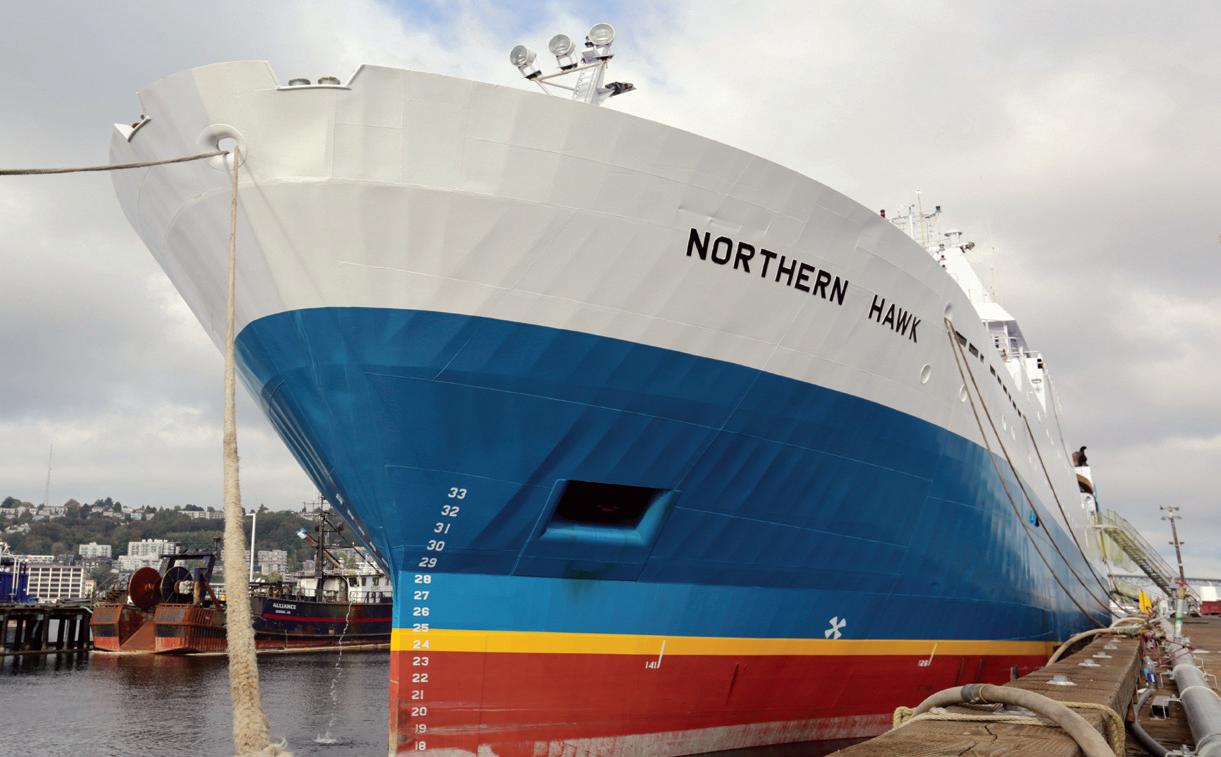
1
our partnership, bringing corporate technicians into the region to work side-by-side with local mechanics. Beyond training, it was a cultural exchange grounded in shared purpose and mutual respect.
Throughout the year, CVRF continued to invest in the future: from scholarships and internships to our Youth to Work program, we helped connect the next generation to opportunity while preserving traditions that sustain us. People Propel® remained a vital tool for bringing our subsistence traditions forward, helping hundreds of residents acquire equipment essential to everyday life.
As we look ahead, our focus remains clear. CVRF will continue to defend sustainable Alaskan fisheries, invest in community capacity and build partnerships that reflect both local values and global opportunity. Whether it’s mapping future streets, utilizing future harvests or training future leaders, we’re working to ensure that Western Alaska is ready for what’s next.
Together—with our communities, our partners and our people—we are navigating the currents of change.
636,343 POUNDS

Built: 1981/1990
Dimensions: 341 feet x 52 feet
Tonnage (Gross/Net): 3,582/1,647
Horsepower: 8,800
Crew Size: 130
Hold Size: 81,223 cubic feet
Seafood Harvested: Pollock
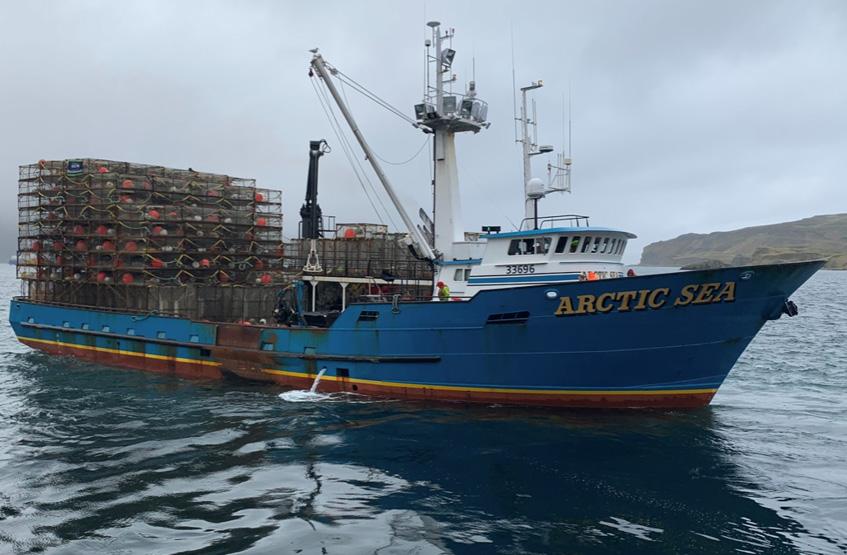
Built: 1978/1991
Dimensions: 135 feet x 46 feet
Tonnage (Gross/Net): 341/284
Horsepower: 1,410
Crew Size: 7
Hold Size: 17,970 cubic feet
Seafood Harvested: Crab

Built: 1984/2018
Dimensions: 140 feet x 34 feet
Tonnage (Gross/Net): 197/84
Horsepower: 1,300
Crew Size: 21
Hold Size: 14,807 cubic feet
Seafood Harvested: Cod

Built: 1979
Dimensions: 126 feet x 30 feet
Tonnage (Gross/Net): 193/135
Horsepower: 1,410
Crew Size: 6
Hold Size: 9,500 cubic feet
Seafood Harvested: Crab
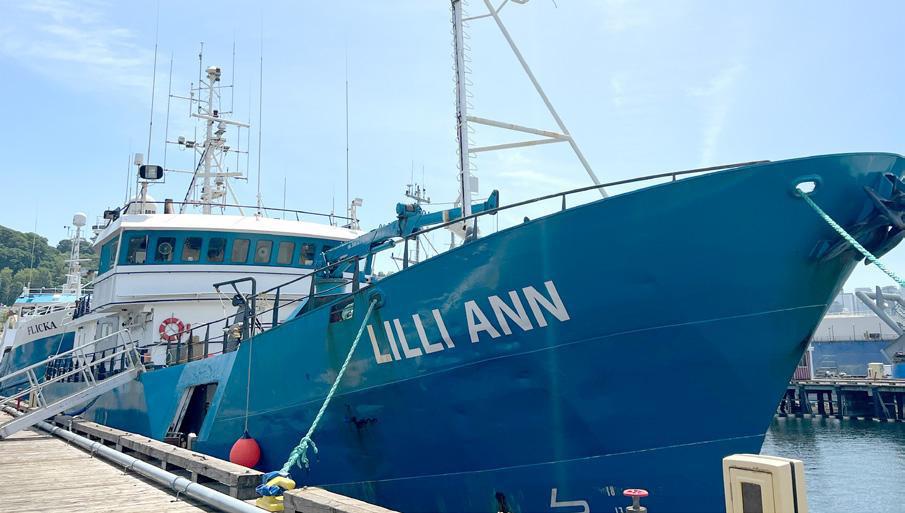
Built: 1991
Dimensions: 141 feet x 31 feet
Tonnage (Gross/Net): 479/326
Horsepower: 1,410
Crew Size: 20
Hold Size: 15,900 cubic feet
Seafood Harvested: Cod

Built: 1988
Dimensions: 106 feet x 26 feet
Tonnage (Gross/Net): 199/100
Horsepower: 1,280
Crew Size: 5
Hold Size: 7,406 cubic feet
Seafood Harvested: Pollock
Each of the pictured vessels is currently active and 100% owned by Coastal Villages Region Fund. CVRF is also part owner of 15 other active vessels:
In 2024, CVRF continued to fish responsibly and uphold a long-term commitment to stewardship.
This commitment was reflected in our Northern Hawk bycatch results: 152 Chinook and 121 chum salmon were recorded across the year’s fishing seasons. Compared to 2023, these numbers represented a significant reduction, with decreases of nearly 70% and 84% in Chinook and chum bycatch, respectively
The reductions reflect CVRF’s steady focus on minimizing negative impact wherever possible, acting with care on the water, and protecting the resources that sustain Western Alaska’s communities.
Throughout the year, CVRF crews leaned on experience, careful planning and day-to-day vigilance. They made thoughtful, informed decisions rooted in a data-driven approach that the company has embraced when it comes to fishing strategy, based on shared industry intelligence and real-time ocean conditions—relocating whenever needed to avoid areas of higher salmon presence.
CVRF has developed comprehensive dashboards that track historical bycatch patterns, allowing crews to identify areas and times when salmon encounters were historically lower. This historical analysis is supplemented by real-time genetic sampling programs that help distinguish between Asian hatchery fish and wild Alaska salmon, potentially informing decisions about where continued fishing might be more acceptable. These innovations, along with collaborations with research groups, have laid the groundwork for even more informed decision-making in the future.
Additionally, CVRF’s continued investment in tools like underwater cameras, escapement technologies and targeted LED lighting further supported this work, providing captains with better ways to spot risk early and act quickly. CVRF continues to investigate new potential solutions to mitigate bycatch further, from specialized, species-specific excluder technology to even more sophisticated data models driven by artificial intelligence and machine learning.
While factors such as ocean temperatures and foreign hatchery competition remain outside any one fleet’s control, CVRF’s approach remained rooted in what can be controlled: a commitment to continuous improvement, collaboration with industry partners and proactive leadership within Alaska’s sustainable fisheries.
It’s a responsibility to the region, to future generations and to the oceans that always provide. In 2024, CVRF’s actions on the water embodied that responsibility.
NUMBER OF CHINOOK SALMON (2003-2023)
(2004-2024)
SOURCE: NOAA Fisheries https://www.fisheries.noaa.gov/sites/default/files/akro/chinook_salmon_mortality2024.html
SOURCE: NOAA Fisheries https://www.fisheries.noaa.gov/sites/default/files/akro/chinook_salmon_mortality2024.html
Bering
SOURCE: NOAA Report to the North Pacific Fisheries Management Council, April 2025*
In rural Alaska, where the cost of basic goods is exacerbated by the cost of air freight, even a small subsidy can make a big difference. That’s why People Propel® CVRF’s equipment support program—continues to be a valuable lifeline for residents across the region.
Launched as a loan program in 2013, People Propel originally focused on boats, outboards and nets—the essentials of fishing. Today, it has evolved into a 30% costshare program that now includes ATVs, snowmachines, outboards and other essentials for all subsistence activity in the Yukon-Kuskokwim Delta.
In 2024, People Propel infused $916,829 into CVRF’s 20 communities. That financial support means something different to every household. For some, it’s getting an outboard motor in time for the fishing season. For others, it’s replacing a snowmachine used to check traps or deliver firewood.
For elders like PETER PAUL of KIPNUK , it’s about preserving independence and staying rooted in the place he’s called home for over 75 years.

“With the rising cost of freight and the products that we need, especially in the rural area, that 30% support really helps, particularly the elders,” he said. The added funding, he continued, means he and many others can divert their Alaska Permanent Fund dividend payments towards other vital everyday supplies. In 2024, that meant buying extra wood for repairs, since the effects of erosion made local sourcing difficult and increased lumber costs.
Peter, a military veteran and former fisherman, has participated in the program since its earliest rounds. He continues to advocate for People Propel locally—not just for the savings it brings, but for the self-sufficiency it protects.
“When I used to fish, I bought a fishing boat back then,” he said. “It just cracked up over time, so I bought materials through CVRF and fixed it myself. It’s still here. It’s a real plus for me—if I would have tried to take it somewhere else to be fixed, it would have cost that much more, so I saved a lot of money.”
CALVIN TOM of NEWTOK uses the outboard motor he was able to purchase through People Propel to hunt for moose and fish for salmon, halibut and herring. With the money he was able to save through the program, he was able to put more into groceries, equipment maintenance and purchases for his family.
Tom, who serves as tribal administrator for the village, said that he sees the benefits reaped by residents through the program every day.
“I always see people here getting new snowmachines, new outboards—you name it,” he said. “Anything that falls within the People Propel program, people utilize that and it helps everyone out a lot.”
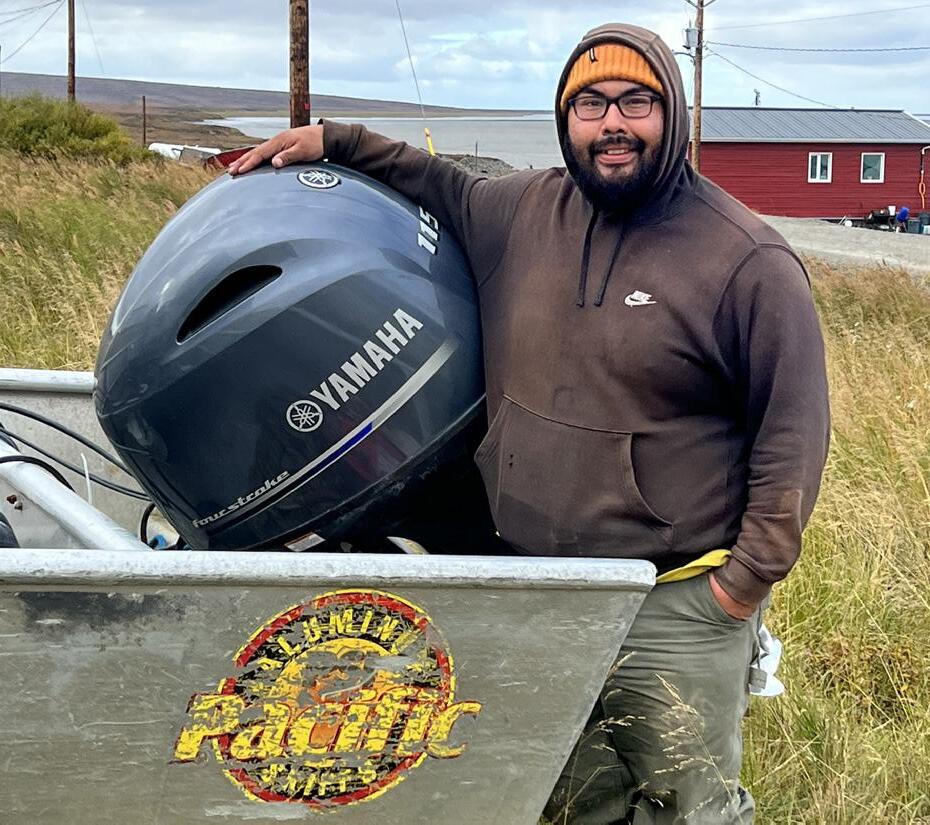
After years of groundwork, CVRF’s Geographic Information Systems (GIS) program began transforming technical data into practical community tools throughout our region in 2024. New street-addressing systems began taking shape across multiple communities, drone pilots continued capturing high-definition village imagery and ocean buoys were used to measure critical water level data. What began as digital dots on screens is now being transformed into real-world tools that advance our communities’ futures.
One of the significant milestones in 2024 was the Toksook Bay addressing project.
In many rural Alaskan communities, the lack of physical addresses makes it harder to apply for disaster aid, get loans, obtain a Real ID or receive e-commerce deliveries. The GIS team’s completion of a comprehensive physical addressing system for Toksook Bay, following National Emergency Number Association standards to ensure addresses are properly linked to parcels, plats, deeds and easements, represented a major step forward.
The process was meticulous and collaborative, combining technical precision with community engagement. After presenting their vision to local leadership—and with support from consultant Gary Greenberg of the Alaska Map Company—the team produced both the detailed maps and legal ordinances needed to establish Toksook’s addresses officially.
Teamwork with the community was particularly strong because RODERICK ATTI, CVRF’s lead GIS technician, is from TOKSOOK BAY. This allowed for easier communication with city leadership about community priorities for street names and addressing conventions.
“Collaboration made this a very successful project,” said Roderick. “Without the shared effort, we would have not gotten this far, and it would have taken a lot longer than anticipated.”
By the end of 2024, the groundwork was finished and Toksook Bay was readied to be added to the National Address Database. Meanwhile, the team’s work expanded beyond Toksook Bay: Nightmute had passed its own addressing ordinance, and Kwigillingok, Quinhagak, Mekoryuk and Tununak were reviewing their draft ordinances.
In 2024, CVRF’s GIS program really took flight—literally. Team members became certified drone pilots and began capturing high-resolution aerial imagery to replace outdated satellite maps.

We initiated these projects because we heard from community members that there was a need, but we didn’t anticipate how much interest and how much engagement there would be from local governments.
NATHANIEL BETZ DIRECTOR OF COMMUNITY PROGRAMS

“We’re using the drone program to get better imagery for our communities,” explained JANELLE CARL, a community benefits coordinator on CVRF’s GIS team in KIPNUK. “The existing imagery isn’t really updated.”
Roderick explained that the team’s drone work in 2024 was all for training purposes, but as with the addressing project, that important groundwork will lead to bigger things beyond 2024.
“We’re hoping later in 2025, we will have data that will be presentable towards a potential grant from the U.S. Economic Development Administration and to our local entities that we’ll want to share,” Roderick said.
Once fully operational, the drones will do more than create clearer, more current maps. Using specialized software, the team can process drone imagery to create digital elevation models, providing precise data about community topography—crucial for monitoring erosion, flood risks and sinking land.
CVRF also deployed a SOFAR Spotter buoy to collect water level data. This floating instrument uses pressure sensors to

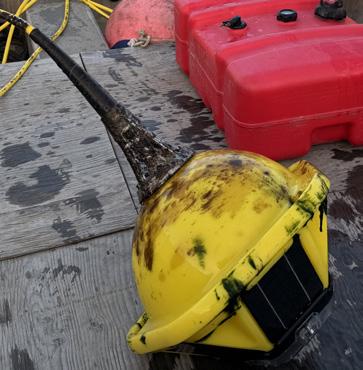
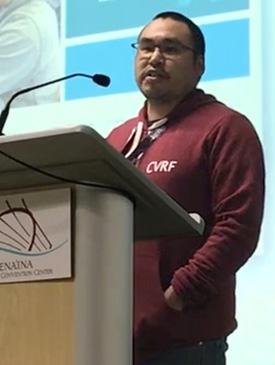
measure water depths, helping communities track tide levels with unprecedented precision.
“At the time we started this work, there were very few examples of systematic and sustained water level measurement around the Yukon-Kuskokwim Delta,” noted CVRF Director of Community Programs NATHANIEL BETZ, who manages the GIS program.
“There was no contemporary tide data for the area around Toksook Bay, where our team started collecting data in 2024.”
But by combining elevation data from drone mapping with water level readings, CVRF is building a more complete picture of environmental risks facing coastal communities.
What started as a data collection effort has evolved into a sustainable local capability that community governments can increasingly rely upon. The GIS team intentionally partnered with consultants who would help them develop independent capabilities rather than creating dependency.
This approach means that as Internet connectivity improves in
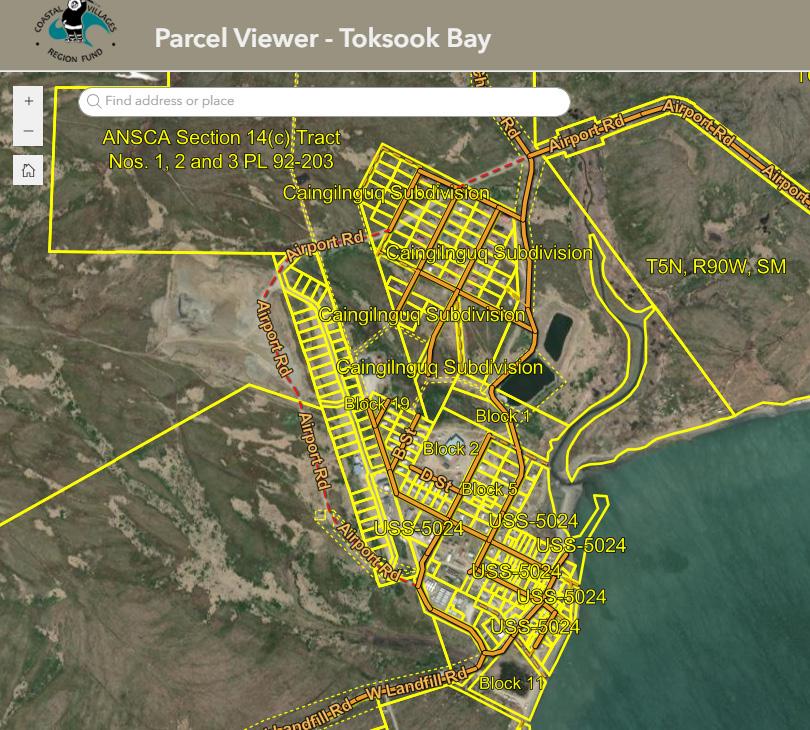
rural Alaska, CVRF’s GIS team is opening up new career pathways for residents.
“The work that Roderick and Janelle have done since 2021 has really opened up an entirely new, largely web-based career field for people looking for technology jobs in rural Alaska,” said Nathaniel.
Looking ahead, the GIS team plans to expand addressing work to more communities, collect complete drone imagery datasets, and integrate water level monitoring into their systems—transforming digital data into practical tools that strengthen resilience in CVRF’s member communities. According to Nathaniel, the enthusiasm for the team’s efforts has already exceeded expectations.
“There is a tremendous appetite for the data that we’re producing, whether it be the addressing, mapping parcels, allotments, topographical data or the water levels,” said Nathaniel. “We initiated these projects because we heard from community members that there was a need, but we didn’t anticipate how much interest and how much engagement there would be from local governments.”
When KRISTEN MAXIE left her home in NAPASKIAK to attend the University of Alaska Fairbanks, she wasn’t sure what to expect. As a first-generation college student, the transition from a rural village to an urban campus was both exciting and overwhelming. But with help from the Louis Bunyan Memorial Scholarship from CVRF, she found the inspiration—and the resources—for her next step.
“I view this scholarship as way more than financial aid,” Kristen said. “This scholarship shows me that I am supported and encourages me to pursue my goals. It reminds me that I am capable of doing more, and that I can do more not only for myself, but for my region, too.”
She’s not alone: CVRF awarded $156,100 to 42 students like Kristen through scholarships in 2024. The program, initially established in 1993, awards students up to $4,000 each for two- and four-year colleges, vocational schools, and certificate programs.
ASA PITKA , a fisheries student from TOKSOOK BAY also attending the University of Alaska Fairbanks, hopes to parlay the CVRF scholarship into a career giving back to his community. He’s pursuing a degree in fisheries with a minor in business and hopes to contribute to sustainable fisheries management and long-term resilience for communities in the Yukon-Kuskokwim Delta.
“I plan to use my education in fisheries to contribute to sustainable fisheries management and conservation efforts, particularly in Alaska,” said Asa. “With my background, I aim to work in fisheries research, policy development, or resource management to ensure the long-term health of fish populations and the communities that depend on them.
“Fisheries are vital to Alaska’s economy, culture, and food security,” Asa continued. “I want to use my knowledge to help ensure our region’s fish populations remain healthy for future generations.”
Kristen’s academic path is similarly rooted in home. She is turning her experiences growing up in rural Alaska into a path of service, studying a combination of psychology and justice. She has taken full advantage of opportunities to explore career paths, working with the Kuskokwim River Intertribal Fish Commission as a knowledge steward and planning to shadow attorneys at Calista this summer. Long term, she’s considering forensic psychology or a deeper dive into legal advocacy.
“I’m trying to take as many opportunities as I can,” she said. “I know I want to blend justice and psychology, but I’m still learning where that path leads.”
For both Kristen and Asa, CVRF’s scholarships have helped shift focus away from finances and toward academic goals.
“Receiving the scholarship has significantly impacted my educational journey by alleviating financial stress and allowing me to focus more on my studies in fisheries,” Asa said.
“If it weren’t for CVRF funding this semester, I probably wouldn’t be able to live on campus—or I’d have had to take out another loan,” echoed Kristen. “This scholarship is one of the reasons I can keep going.”
Asked what advice they’d offer to other young people in CVRF’s member villages, both shared the same message: Go for it.
“You don’t have to have everything figured out,” said Kristen. “That’s what college is for. Always keep an open mind. Learn about yourself, your goals, your ambitions— and take the next step in your journey.”
“These scholarships can open doors to new experiences, knowledge and career opportunities,” added Asa. “I would also remind them that their education can have a lasting impact, not just on their own future but on the future of our community as well.”
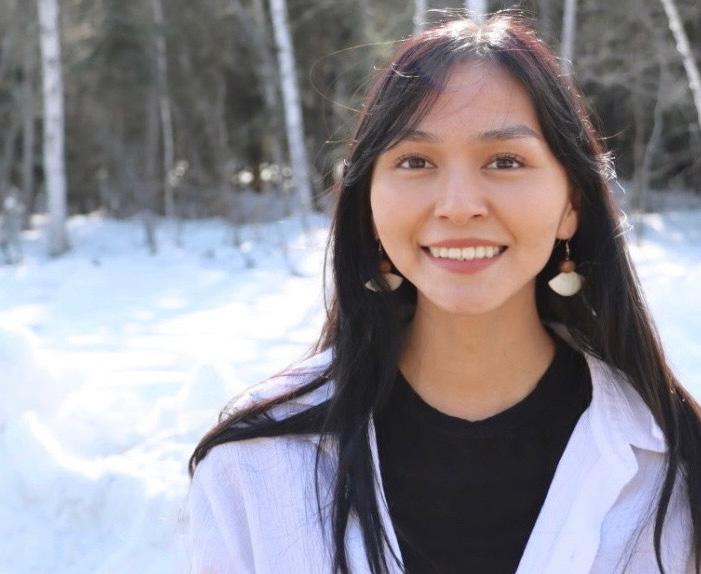

For young adults in CVRF communities, the in-region internship program is more than a summer job. It’s a hands-on opportunity to build career skills close to home.
In 2024, five interns supported CVRF operations in their home villages, gaining real-world experience while earning a collective $34,310 in wages. Interns received focused coaching, took on meaningful assignments, and learned the day-to-day of office operations—all without needing to leave their communities.
KELSEY WHARTON, a second-year nursing student at Alaska Pacific University, interned in EEK , where she answered phones, helped manage the internet café, and supported the Youth to Work program.

“I would recommend it,” she said. “It’s a good experience of how an office job might be. I learned how to be patient, how to do stuff on the computer and just communicate better.”
Internship Program Coordinator DELORAS LOZANO noted how valuable the experience is for interns who are starting to imagine their future careers.
“They grow more mature,” she said. “Their confidence and leadership skills get stronger—they’re willing to do more.”
For Kelsey, the experience was confidence-building.
“Now,” she said, “I feel more prepared for whatever job I go into.”

In CVRF communities, summer brings long days filled with possibility—and for many teens, the Youth to Work program offers a powerful first step into responsibility, community service and cultural skill development.
In 2024, 596 young people took part in the program. For many, it was their first job—delivering tundra greens to elders, cleaning churches, painting signs and even crafting wooden house number plates for the GIS addressing project in Toksook Bay. Others got their first taste of job shadowing—filing papers at the tribal office, stocking shelves or answering phones. Twenty-nine youths participated in Youth to Work Maritime, which offers fishing industry experience and a Coast Guard-approved Nautical Skills Certificate.
“The first-timers come in pretty quiet, pretty shy,” said Program Lead BRENDA ERIK . “They weren’t communicating with other
students or participants. And then as they return every year, they grow and become more communicative with other students.”
For some, Youth to Work is proving to be just the beginning. CHEFORNAK ’s LEBRON WALTER , who prefers to be called MAKSII, went through the Youth to Work Maritime program before being selected for an internship aboard the Northern Hawk. Impressing the captain and crew with his shipboard skill and hard work, Maksii was one of the youths invited back to work as a crew member for the remainder of the season.
His journey is a strong example of what CVRF’s programs can make possible: a clear path from learning to earning.
“I definitely recommend participating in these programs,“ he said. “Work hard. Ask questions. Take full advantage.”

In the remote villages of Western Alaska, a small engine is more than just transportation—it’s a lifeline.
When a snowmachine breaks down in winter or an outboard fails during fishing season, it can affect a family’s ability to hunt, fish, and maintain their way of life. That’s why maintaining and repairing this equipment locally is so critical to village residents.
Recognizing this vital need, CVRF and American Honda Motor Co. took their ongoing partnership to a new level in August of 2024. Four Honda technical experts traveled to Scammon Bay for an intensive weeklong training session—the first time Honda technicians had ever visited rural Alaska to conduct training.
Eleven mechanics and welders from CHEVAK, HOOPER BAY, KONGIGANAK, NAPAKIAK, TOKSOOK BAY and SCAMMON BAY participated, gaining hands-on experience, troubleshooting real-world issues and exchanging knowledge with Honda’s factory-trained team.
The visit marked a full-circle moment in the CVRF-Honda partnership. Four years earlier, CVRF mechanics had traveled to Torrance, California, to train at Honda’s U.S. headquarters. This time, the learning happened on local ground—and Honda staffers saw firsthand how essential their ATVs, UTVs and outboard motors are in powering the rural Alaskan way of life.
“Honda is the number one ATV in Western Alaska,” said ERIC DEAKIN, CEO of CVRF. “They actually call all ATVs ‘Hondas’ because it’s so ubiquitous. There are a few other
brands out there, but I would say 90% of ATVs in our region, if not 95%, are Hondas.”
“Coming here really helped Honda’s technicians understand that we use our ATVs for something other than going out on a weekend and just riding the country,” added GEORGE SMITH, manager of CVRF’s Mechanics/Welders programs.
One of the first clues came from the machines themselves.
“The very first thing that one of the guys asked me was, ‘Why are all the fenders or the front bumpers on these ATVs all bent up?’ And we just brought him down to the river and we showed them: This is how they push their boats down into the river, with a Honda ATV.”
The visit also offered Honda techs a window into the harsh conditions Honda machines often face in Alaska’s rugged frontier. The cold and the atmosphere create unique mechanical challenges, making anticipating damage just as important as repairing it.
“It’s very important to do our maintenance here,” said DARRELL WALKER, supervisor of CVRF’s HOOPER BAY mechanics/welders’ facility. “We have a lot of salt in our air, because we live right next to the ocean. That makes a lot of things rust on our vehicles. We have a lot of corroded vehicles with wiring issues here.”
Understanding such challenges helped Honda’s trainers tailor their training session.
“They gave us a lot of tools of the trade,” Walker said. “They gave us a lot of pointers on how to troubleshoot things right away.”
Takeaways from the field are crucial for product line evolution, said American Honda’s JEREMY MERZLAK especially when it comes to catering to customers like the residents of the Yukon-Kuskokwim Delta.
“Product reliability is always a priority for Honda, and it’s even more important in remote areas, typified by many Alaskan communities,” said Jeremy, the company’s aftersales experience division director at American Honda. “A big part of ensuring reliability, especially in the long term, is a well-organized maintenance and repair program, something that we’ve worked hard to create with our CVRF partners.
“This collaboration benefits these mechanics and their customers, but it’s also an opportunity for us to learn from their experiences in extreme conditions. That knowledge ultimately results in improved products, creating a circular positive process that has already proven to be extremely valuable.”
Thanks to CVRF mechanics’ feedback, that process has already yielded tangible results, George noted.
“After a certain temperature, your oil gets so thick that the electric starter won’t even crank your engine, so we can’t rely on electric start year-round,” he explained. “Honda actually came out with an Alaska-only model where they have a recoil starter installed, because of our cold winters. That was all due to our guys at the shops letting the technicians from Honda know that there’s got to be better things for us up here.”
For Honda’s team, it was also a chance to see how rural technicians are adapting to challenges that simply don’t exist elsewhere.
“It’s definitely something that I feel is admirable,” said TREVYN DAYS, a district service manager for Honda Marine who visited Scammon Bay. “They do an amazing job with what they have. That’s just the way of life. If you don’t have something, you make it yourself, or if you can’t fix it, you find a way.”
As the Honda technicians departed Scammon Bay, they left behind more than just technical knowledge— they reinforced a partnership that acknowledges the essential role of local expertise in rural Alaska.
The investment in training is already paying dividends for communities. Mechanics have returned to their villages with enhanced skills, specialized tools and renewed confidence in tackling complex repairs. For residents, this means more reliable service, quicker turnaround times and equipment that can be properly maintained without significant investments in time and money.
“We have been able to expand our relationship with Honda so that Alaskans can save time and money on repairs and support our traditional ways of living off the land,” Eric said. “It is impressive that a global company such as Honda invests in creative partnerships like ours to maintain the cultural and subsistence needs of even the most remote communities of the world.”

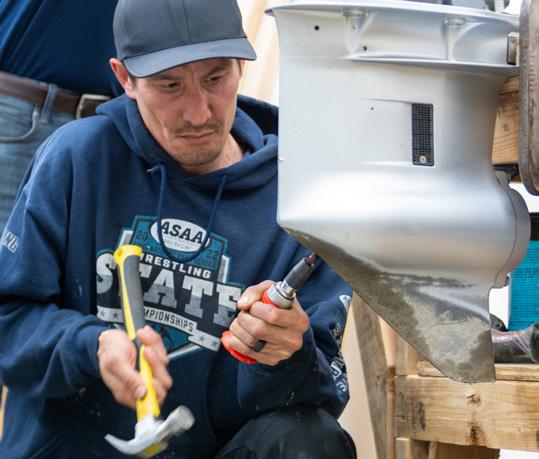
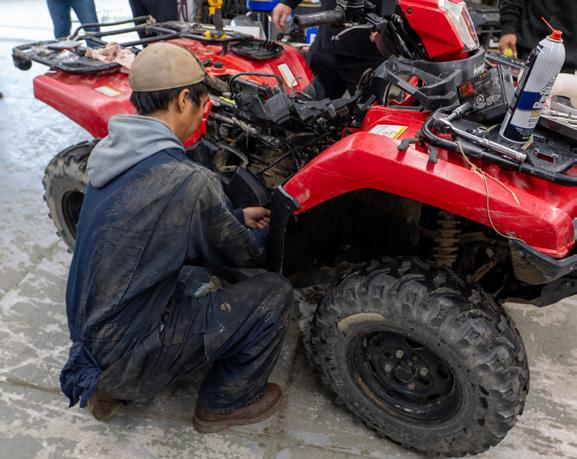
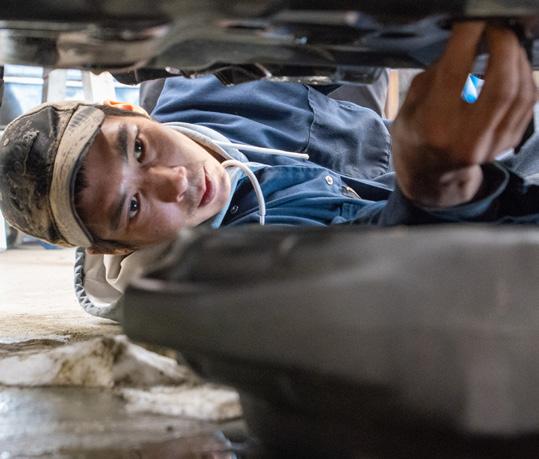

In 2024, CVRF’s Mechanics/Welders program reached a major milestone: $1.12 million in service revenues across the 20 member villages, marking the first time it has ever crossed the million-dollar threshold.
This milestone shows that the program continues to gain momentum as a crucial resource for the people of CVRF’s member communities. Across CVRF’s communities, mechanics and welders provide important services in places where there are no dealerships, limited spare parts access and little margin for error. In 2024, our technicians processed 8,109 work orders for 2,140 customers, up from 7,461 and 2,055 one year prior.
For the teams on the ground, the impact is measured in small moments—one repair at a time.
“We pretty much have a snowmachine or a Honda in here every day,” said DARRELL WALKER , who supervises the HOOPER BAY Community Service Center. “It’s a busy shop.
“We’re the only shops out here in our communities,” he added. “And that’s a big thing for our people here because some people don’t know how to work on these kinds of things on their own, and they look towards us to fix them for them. That’s very important because we use these machines yearround in our community.”
Darrell has worked with CVRF for five years, growing from part-time mechanic to full-time team lead. In 2024, he helped expand his local shop’s capabilities by learning how to use diagnostic software for
snowmachines—equipment that used to require a long trip hauling a faulty snowmachine.
“In the past, our community members would have to drag their snowmachine all the way up to Scammon Bay,” Darrell said. “That’s like an hour and a half drive just to have their snowmachine looked at with a computer. Now the community doesn’t have to do that anymore. We can do it right here in Hooper Bay.”
GEORGE SMITH , regional manager of the Mechanics/Welders program, noted that program technicians “spread their wings” in 2024 by training to fix more home-based equipment, like Toyostove heaters. Many locals look to professionals in the Mechanics/Welders program as knowledgeable repair servicemen, George said, and with requests coming in from residents who need help with home repairs, it made sense to branch out.
“We even had a request from one of the residents at one of our communities asking if the mechanics could change out his floor in his house,” said George. “That was sort of unique, but we did it.”
George emphasized that the value of the program goes beyond technical know-how—it’s about employment, training and growing local talent, as well as showing our communities that there are reliable resources on hand if they need them.
“We have guys that people trust to do the job,” George said. “That’s the biggest reason people come to us for anything and everything.”

We have guys that people trust to do the job. That’s the biggest reason people come to us for anything and everything.
GEORGE SMITH, MANAGER CVRF M/W PROGRAM
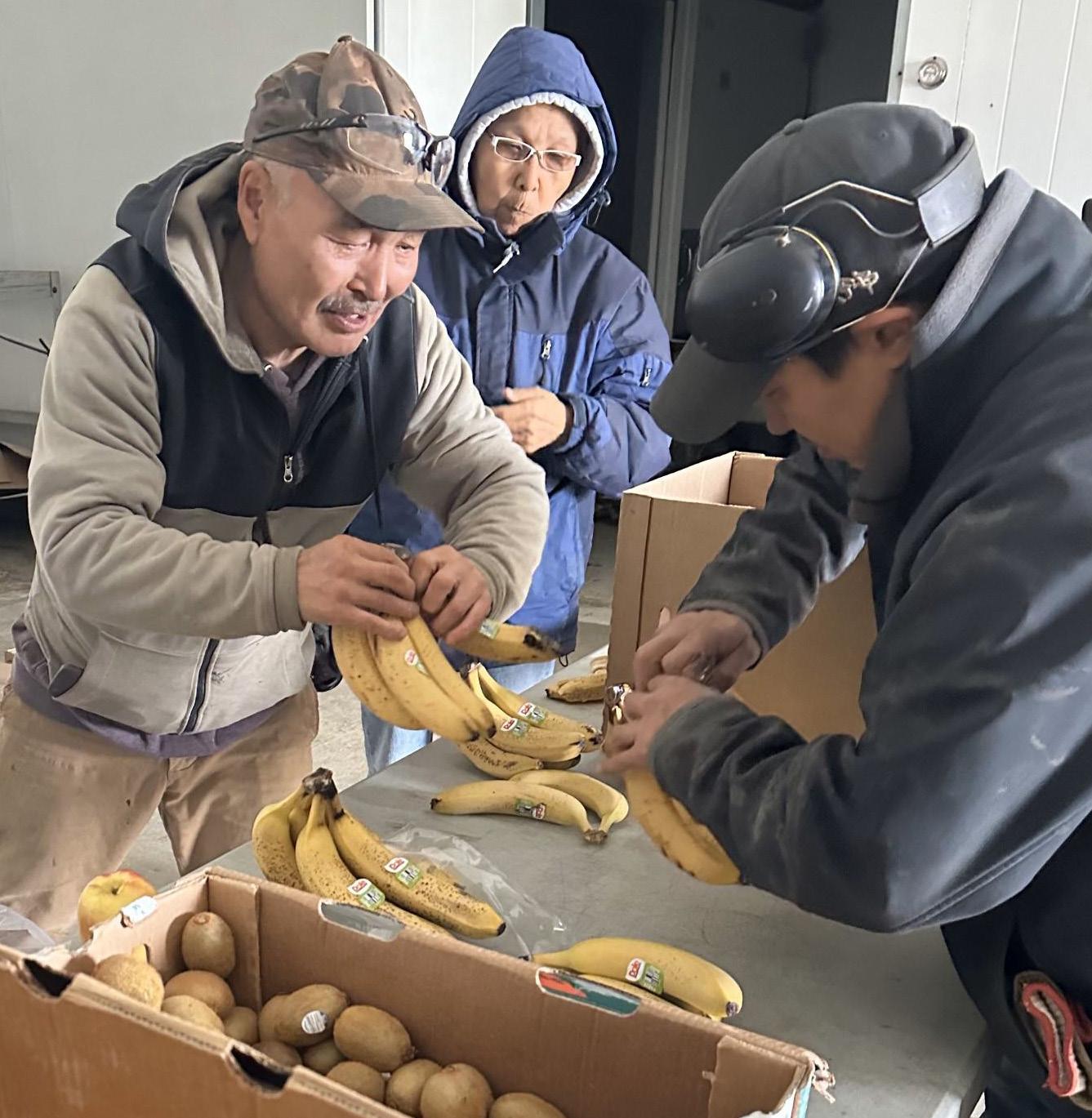
FEEDING OUR COMMUNITIES
On Oct. 7, 2024, Copper River Seafoods gave SeaShare a bid invitation for 2,500 lbs of frozen Keta, pink or sockeye salmon for Hooper Bay, to be shipped from their Anchorage value-added processing facility. On Oct. 30, 55 boxes totaling 2,502 pounds of sockeye and halibut packs were shipped from Anchorage to Hooper Bay via Everts Air Cargo and Ryan Air. CVRF personnel verified that the fish were in good condition.
A community-led pilot program in CVRF’s member villages is showing what food security can look like when resources—and trust—stay close to home.
What began as emergency salmon distributions after Typhoon Merbok in 2022 has grown into a more structured, strategic effort. With many areas still on the road to full recovery, CVRF has stayed diligent in assisting Western Alaska residents—delivering approximately 2,500 pounds of portioned fish to Hooper Bay, supplemented by two additional shipments from nonprofit partner SeaShare.
“Our communities trust CVRF to get them good fish” said Janet Erik, Projects Development Coordinator at CVRF. “And it’s not just about food—it’s about quality, tradition and being able to share with family and elders.”
This distribution effort was more than a handoff. Area residents took point on coordinating food allocation and ensuring that elders, families and those most in need received that high-quality seafood in a way that reflected community priorities.
It’s an early success for a CVRF-supported pilot focused on self-determined food access and resource management. That approach, with delivery and prioritization led locally, reflects the organization’s belief that long-term food security starts with community control.
Rather than directly operating food programs, CVRF is focused on building capacity within its communities to access and manage resources independently. In Hooper Bay, that includes expanding vital infrastructure: CVRF helped secure a 40-foot freezer container for the community.
SeaShare donated the fish, and American Seafoods subsidiary Alaska Reefer Management covered shipping costs. The facility addresses a critical gap by providing shared cold storage for wild-harvested foods—especially important in a region where power outages caused by extreme weather like Merbok can cause home freezers to fail and valuable subsistence harvests to spoil.
The container, set to be connected to power by fall 2025, will provide year-round storage and serve as an area hub for food distribution, including collaboration with the Alaska Department of Education’s Head Start program.
HANNAH LINDOFF, SeaShare’s executive director, said that CVRF has been a vital partner in its mission to combat food insecurity in a difficult region to access.
“We spend most of our money on seafood and shipping, so we don’t have a lot of staff,” she explained. “It’s vital that we have strong partners within the industry and within communities that we’re serving. For us, CVRF is both.”
Meanwhile, CVRF has also played a connective role, helping communities connect to underutilized state programs like The Emergency Food Assistance Program (TEFAP), ensuring that long-term food support is not just available—but accessible.
“This isn’t about creating dependency,” emphasized CVRF CEO ERIC DEAKIN . “We’re working with partners across the industry and the state to build infrastructure, partnerships and local ownership that strengthen selfsufficiency in our communities.”
What does a fish hot dog in Tokyo have to do with a robot fillet line in Reykjavik?
For CVRF in 2024, the answer was clear: They’re both shaping the future of seafood.
CVRF’s leaders traveled to two different corners of the world this year to forge stronger partnerships and learn new ways to support the people and economies of Western Alaska. In Japan, they met with the world’s largest wild seafood company. In Iceland, they toured cutting-edge processing plants to see how automation and innovation are redefining quality.
“We’re out there learning how to do things better—and bringing that knowledge back to our people,” said CEO ERIC DEAKIN
Two trips. Two continents. One mission: Make the evolving global seafood economy bring back more value for the people of the Yukon-Kuskokwim Delta.
In Tokyo, CVRF leaders sat down with executives from Maruha Nichiro, the world’s largest wild seafood company and a key buyer of CVRF pollock. Board Chair LARSON HUNTER and Director of Sales and Marketing NICK SOUZA joined Eric and COO RUDY TSUKADA for high-level meetings with Maruha’s CEO, part of a broader effort to fortify one of CVRF’s most critical international partnerships.
The team also toured Maruha’s processing facilities where CVRF pollock is turned into products like kamaboko (cured fish cake) and fish sausages—popular items in Japan that show up everywhere from convenience stores to baseball stadiums.
“Japan treats pollock with a level of product diversity you just don’t see in the U.S.,” said Rudy. “The pollock market here in America is fish sticks and Filet-O-Fish sandwiches. And while the fish fillet is still relatively important in Japan, the breadth of pollock products there was a real educational experience.”
“They’ve got some products that are shelf-stable, kind of like a Slim Jim, and others you heat up and eat like a hot dog,” echoed Eric. “It’s a totally different product world than what we see here.”
The trip also offered a chance to reinforce one of CVRF’s biggest advantages in Japan: the authenticity of its mission.
“Coastal Villages has a unique story: we’re a nonprofit in one of the world’s most competitive businesses,” Rudy said. “Our partners hear directly from our board members that every dollar goes back to economic development in some of the most remote regions in America. That makes a difference— and it’s opening more doors for us around the world.”
Between the quality of CVRF’s product and the strength of its message, Eric noted the impact is already being felt on a global scale.
“You go halfway around the world, and people are asking for our product by the logo,” Eric said. “Our Western Alaska brand? People are seeking it out. It means something.”
A separate industry delegation’s trip to Iceland centered on one big question: How can Alaska do more with every fish?
Iceland has spent decades developing cutting-edge seafood processing, and Eric saw some of those innovations at work firsthand at some of the country’s most advanced plants.
Our partners hear directly from our board members that every dollar goes back to economic development in some of the most remote regions in America. That makes a difference—and it’s opening more doors for us around the world.
Water-jet robots portion fillets with extreme precision. X-ray machines scan for hidden bones. Robotic forklifts move totes of fish from docks to processing lines.
“In seafood, consistency is everything,” Eric said. “It’s about creating a perfect, consistent, high-value product every time. Iceland invested in technology and figured out how to use technology to deliver that all the way to the customer.”
One standout technology was super chilled slush ice—a system that instantly chills fish inside and out, preserving freshness far longer than traditional methods. With this approach, Icelandic cod can stay fresh up to 20 days without
In 2024, CVRF totaled more than $85 million in gross revenue through international seafood sales, distributed across nine different countries worldwide. Thanks in part to the company’s global outreach efforts, sales are growing in places like Japan, with those gains going back toward supporting CVRF’s member villages.
freezing, allowing processors to charge premium prices in markets like France. CVRF is now exploring ways to bring elements of this technology to our own operations, which could significantly improve product quality and shelf life of CVRF products
The trip reinforced a simple but powerful idea: If Alaska wants to remain competitive in the worldwide seafood industry, it must invest in quality, not just quantity.
Whether it’s unlocking efficiency through Icelandic tech or building deeper connections in Japan, CVRF’s global efforts share one goal: preparing the company and its member communities for what’s next.
They’re investments in both opportunity and resilience—fueled by respect, grounded in culture and shaped by the needs of the
more than 9,000 residents CVRF serves. Every lesson learned and every relationship built is another step toward a stronger future for the people of Western Alaska.
“As we grow our brand internationally,” said Eric, “we’re doing it with our people and our values at the center. We want the world to know what Western Alaska can do.”
The CVRF Bylaws create a CVRF Executive Committee consisting of seven members: the CVRF Board President, Board Vice President, Board Secretary, Board Treasurer, and three at-large CVRF Board members. The CVRF Executive Committee may exercise all authority of the full CVRF Board in managing CVRF, except for the election of CVRF officers and Executive Committee members.
The CVRF Bylaws also authorize the Board President, with affirmation from a majority of the CVRF Board, to appoint other CVRF committees with such functions, powers, and duties as determined by the President and CVRF Board. Using this authority, CVRF has established several committees comprised of members of the Board of Directors:
• A Policy/Compensation Committee to make recommendations to the Board on CVRF policies.
• A Finance Committee to advise the Board on budgeting and financial matters.
• A Regulatory and Legislative Committee to provide the Board with information about issues of interest to CVRF.
• A Programs Committee to advise on new program initiatives and to review community requests for funding.
• A Fisheries Committee to review and advise on fishing issues directly impacting our communities, including fisheries investments, bycatch, and subsistence matters.
• An Election Committee to advise the company on policies and procedures related to community Board member elections.
• A Disciplinary Committee to make recommendations to the Board on matters of ethics, discipline and other related topics.
For CVRF’s subsidiaries (CAPS, CVP, CVC, CVL, EXS, CVE, CVS, 711 H, FVH, and CPH), CVRF has established subsidiary boards.
CVRF committees and subsidiary Boards are comprised of members of the Board of Directors and CVRF management personnel. These groups met in person or via electronic conferencing as appropriate throughout 2024.
• The Full Board met four times during 2024—March, July, September, and December.
• The CVRF Executive Committee met three times— March, May, and October.
• The subsidiary Boards met in December of 2024 for their annual meetings.
• The Policy and Compensation Committee did not meet during 2024.
• The Disciplinary Committee did not meet during 2024.
• The Finance Committee did not meet during 2024.
• The Election Committee did not meet during 2024.
• The Fisheries Committee did not meet during 2024.
• The Programs Committee did not meet during 2024
• An IAB was convened in April of 2024 for the purpose of reviewing and recommending changes to the board pay rates and structure. Those changes take effect on January 1, 2025.
• There were numerous informal meetings and teleconferences with the President/Vice President and the Administration.
Throughout 2024, CVRF worked through several changes to the corporate bylaws. Due to costs and operational efficiency, most of the standing committees are being eliminated, in favor of ad hoc committees, to be established as needed for specific projects and agendas. Those bylaws changes take effect during in 2025.
In 2023, CVRF initiated several professional service contract requests for proposal, including audit and tax services as a cost savings effort. During 2024, a stand-alone audit was contracted for Excellence Seafoods, and a new firm was selected for the corporate audit. In addition, CVRF contracts for audit services related to its 401k plan, as required by ERISA. In 2024, CVRF paid $271,782 to KPMG, Moss Adams, CBIZ, and HKP & Associates, collectively, for various audit and tax related services. There have been no disagreements with any of the audit firms in any year.
The federal CDQ statute encourages each CDQ group to disclose the “compensation levels of the top 5 highest paid personnel” (16 U.S.C. § 1855(i)(1)(F)(ii)). CVRF has always reported the total amount paid to the company’s top five personnel, whether they are office staff or crew members. Starting with the 2012 annual report, CVRF expanded its report to include the company’s top 10 personnel.
The CVRF Board of Directors works closely with Company leadership and is pleased with the results that the personnel in the company have helped deliver to our communities.
CVRF maintains its commitment to hiring and retaining the best personnel available to benefit our stakeholders and our residents.
The Board follows IRS Rebuttable Presumption of Reasonableness guidelines in calculating the salaries for its top executives, a process completed by an independent contractor, which includes comparisons with salary levels at other similar companies.
For 2024, the top 10 highest paid positions earned the following base salaries (note there were no bonuses paid to these employees in 2024):
• Eric Deakin, CEO, $415,167
• Michelle Drew, CFO, $330,025
• Michael Coleman, Bering Sea Operations Manager, $328,425
• Owen Kvinge, Crab Vessel Captain, $309,244
• Thomas Hindermann, Pollock Vessel Chief Engineer, $302,396
• Christopher Harrell, General Counsel, $292,500
• James Egaas, Pollock Vessel Captain, $283,710
• Sauveur “Chuck” Velasco, Longline Vessel Captain, $270,332
• Nicholas Souza, Director of Sales & Marketing, $255,500
• Francisco Diaz, Pollock Vessel First Mate, $243,423
CVRF Board members receive a daily stipend during meetings and an additional monthly stipend for the CVRF-related work that occurs between CVRF meetings. CVRF’s Board compensation policy was adopted in June 2004 after consultation with an independent advisory board (IAB). The policy stipulates that any changes must be approved by an independent body. The policy was last updated in January 2011 and approved by the independent authorized body comprised of an independent member of each community. An IAB took place in April 2024, and a new compensation scale was adopted with an effective date of 1/1/25.
The CVRF Board compensation policy is in full compliance with IRS Rebuttable Presumption of Reasonableness guidelines. During 2024, CVRF paid its Board members $608,595 including salaries, stipends and benefits.
None of CVRF’s employees or Board members have a financial relationship with any partners who lease or harvest CVRF’s quotas. Related party transactions with Board members include employee payroll:
• Father-in-law: M/W Manager ($139,256)
• Daughter: CSR ($43,442)
• Spouse: Winter Watchman ($12,000)
• Sister-in-Law: CSR ($22,809)
• Daughter: Accounting Associate II ($68,044)
• Daughter: Accounting Associate I ($25,572)
CVRF was not engaged in any litigation with any of its directors during 2024.
In 2024, CVRF paid the following fees for professional services: (1) $29,121 in legal fees; (2) $950,498 in consulting fees; (3) $283,882 in accounting fees; and (4) $194,480 in lobbying fees.
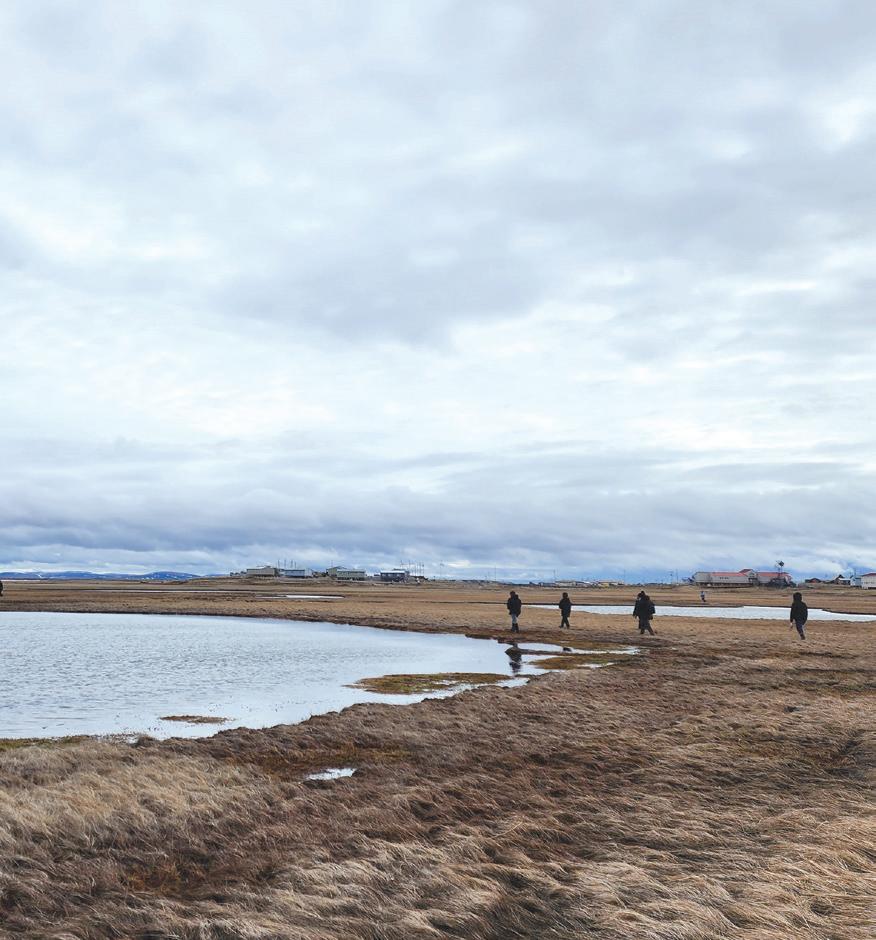
YEARS ENDED DECEMBER 31, 2024 AND 2023
1,595,855 759,592
984,995 9,523,537
1,786,479 14,986,700
12,085,271
7,556,221 10,919,933 1,020,076 — 31,581,501 (16,594,801) (16,594,801)
2,939,974 759,592 1,503,249 984,995 9,523,537 271,500
758,155 832,763 2,311,098 105,084,403 38,586,115 12,085,271 37,555,520 8,535,997 10,919,933 2,665,080 1,049,327 111,397,243 (6,312,840) 1,312,015 (5,000,825) 287,999,452 $ 282,998,627 72,094,317 1,959,167 — 1,399,051 — — — 1,955 1,191,500 348,687 914,932 77,909,609 32,428,317 — 36,754,454 1,332,014 — 1,749,960 183,176 72,447,921 5,461,688 4,026,094 9,487,782 — 1,450,288 933,067 60,396 819,878 5,796,180 1,005,500 500 — — 421,133 10,486,942 — 13,648,807 — 7,124,921 6,237,008 975,871 — 27,986,607 (17,499,665) — (17,499,665) 72,094,317 3,409,455 933,067 1,459,447 819,878 5,796,180 1,005,500 2,455 1,191,500 348,687 1,336,065 88,396,551 32,428,317 13,648,807 36,754,454 8,456,935 6,237,008 2,725,831 183,176 100,434,528 (12,037,977) 4,026,094 (8,011,883) 302,615,040 (6,603,705) $ 287,999,452
The Board of Directors plays an important role at CVRF. It serves as the governing body that steers the vision, mission, values, and policies of the organization. Most importantly, members of the Board provide a critical link between community members and CVRF.
CVRF’s Board of Directors is responsible for governing CVRF’s affairs. The Board makes broad policy decisions and sets organizational goals that the staff carry out. The primary functions of the Board are to act in the best interests of the company and the Coastal Villages region. These functions enable the organization to achieve its purpose of providing the means for development by creating sensible, tangible, long-term solutions for the residents of CVRF’s 20 member communities. The Board makes decisions that balance growth in commercial fishing and sustainable development in CVRF communities.
The Board accomplishes this by staying up-to-date about CVRF’s activities and communicating appropriate information to residents.
CVRF would like to thank all community leaders who have served on the company’s Board of Directors past and present. CVRF is grateful for their many contributions while serving on the Board.
CVRF would also like to acknowledge the contributions that sitting Board members made in 2024. Board members provided valuable guidance and oversight that helped move CVRF closer to achieving some of its long-term goals.
CVRF’s Board of Directors is made up of democratically elected representatives from each of our 20 member
communities. Board members serve six-year terms, and elections for one-third of the board take place every two years. All Board members must be permanently domiciled residents of the communities they represent, meaning that the Board member must have permanent residency and plan to remain a resident. Elections are run under a standardized democratic process designed to give every adult, 18 years or older, the opportunity to vote in the election for the CVRF board member from their community. Thank you to the Tribes throughout our communities for running our elections.
There were no elections held during 2024. In 2025, there are elections for seven regular seats, including three e-board seats, scheduled in the fall, with the new members to be seated in December of 2025.
Albert Williams served on CVRF’s Board of Directors for eight years, but he was more than a member of our board.
“My dad cared about what his position was and what he did,” said his daughter, Theresa Kiokun. “He was at the Community Service Center in Mekoryuk every day. He was there morning and afternoon. He always checked in. He was a community man. That’s what really mattered to him. He was there like it was a job, always at the office.”

LARSON HUNTER CHAIRMAN SCAMMON BAY
JOHN SAMUEL SECRETARY PLATINUM
GEORGE CHUCKWUK EXEC COMMITTEE KIPNUK
EVAN S. EVAN EXEC COMMITTEE GOODNEWS BAY
ALFRED ULROAN CHEVAK
ERIC OLSON, SR. HOOPER BAY
ANDREW KIUNYUA KWIGILLINGOK
LISA CHARLES NEWTOK
RICHARD JUNG VICE CHAIRMAN NAPAKIAK
GABRIEL OLICK TREASURER TUNTUTULIAK
ALBERT WILLIAMS EXEC COMMITTEE MEKORYUK
ROBERT PANRUK CHEFORNAK
CARLIE BEEBE EEK
JERRY IVON KONGIGANAK
JACKIE B. LARSON NAPASKIAK
ISADORE ANTHONY NIGHTMUTE
With a unique understanding of our communities’ social and economic needs, Albert worked tirelessly to further the CDQ purpose and mission. His dedication supported the growth of CVRF and the 20 communities in our region.
CVRF was deeply saddened by his passing in May 2025. Rest in peace, Albert.
NICHOLAI STEVEN OSCARVILLE
SAM A. CHANAR TOKSOOK BAY
JOHN W. MATTHEW QUINHAGAK
ALMA KANRILAK TUNUNAK
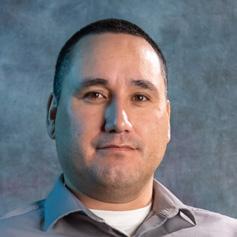
LARSON HUNTER CHAIRMAN SCAMMON BAY
CHAIR TERM: 2022-2027 BOARD TERM: 2022-2027

GEORGE CHUCKWUK EXECUTIVE COMMITTEE KIPNUK
EXEC COMM TERM: 2022-2027 BOARD TERM: 2024-2029

JOHN PINGAYAK CHEVAK
2022 - 2027

LISA CHARLES NEWTOK
2020 - 2025
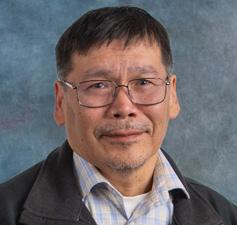
SAM A. CHANAR TOKSOOK BAY
2024 - 2029

RICHARD JUNG VICE CHAIRMAN NAPAKIAK
VICE CHAIR TERM: 2024-2029 BOARD TERM: 2022-2027
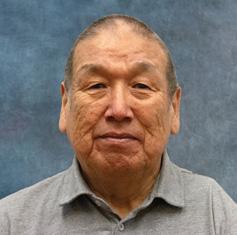
EVAN S. EVAN
EXECUTIVE COMMITTEE GOODNEWS BAY
EXEC COMM TERM: 2024-2029 BOARD TERM: 2022-2027

JERRY IVON KONGIGANAK
2024 - 2029

ISADORE ANTHONY NIGHTMUTE
2022 - 2027

JOHN SAMUEL SECRETARY PLATINUM
SECRETARY TERM: 2020-2025 BOARD TERM: 2019-2025


CARLIE BEEBE EEK
EXEC COMM TERM: 2025 BOARD TERM: 2024-2029

GABRIEL OLICK TREASURER TUNTUTULIAK
TREASURER TERM: 2020-2025 BOARD TERM: 2019-2025

PANRUK CHEFORNAK
2022 - 2027
ANDREW KIUNYA KWIGILLINGOK
2020 - 2025

NICHOLAI STEVEN OSCARVILLE
2024 - 2029
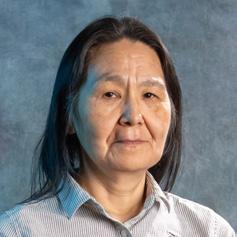
ALMA KANRILAK TUNUNAK
2019 - 2025
VACANT HOOPER BAY
2024 - 2029

2023 - 2025
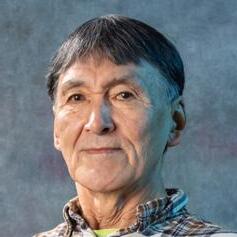
JOHN W. MATTHEW QUINHAGAK
2020 - 2025
MEKORYUK
2024 - 2029
For thousands of years, our existence in Western Alaska was defined by survival. We knew where to hunt, where to fish, and where to gather in order to survive. Our history is an oral one, and the stories of how hard survival could be have been passed down to us. Our ancestors told about times of abundance and times when the animals and fish were harder to find. Our people survived through the millennia so that we could be here today, continuing their traditions but taking advantage of modern life. Today, guns and motorized transport let us hunt and fish where the animals are. Over just a few generations, we transitioned from surviving to setting long-term goals and pursuing passions while maintaining a cultural connection to the land and water.
Of course, this transition has not been free. Housing, power, guns and transportation cost money, which is still hard to come by in our region. Way out here at the far end of every transportation network and supply chain, everything costs more. Jobs are few and far between, especially outside of government. We need more jobs in our region so that more of us can live our lives fully, and be less focused on survival.
That was the vision of Senator Ted Stevens, who in 1989 introduced the first bill to create a community quota program in the Bering Sea region, that would flow the wealth of the Bering Sea to all the villages along its coast. He wanted our communities to share in it and thrive from it. He knew that Western Alaska lacked an obvious economic driver: We do not have oil and gas like the North Slope villages; we lack the timber resources of Southeast Alaska; there were no major mines planned for our region then; and we are far from the road system and the railbelt where the state’s economy works best. We have the most people of any rural region, and the fewest natural resources that can be used to generate wealth. Senator Stevens created CDQ to fix that problem.
In 2024, CVRF paid $4.5 million in wages to residents of our 20 communities. CVRF spent another $12 million on programs, including job training and scholarships, our Youth to Work summer program, heating oil for elders, salmon donations, tax return support, and our People Propel ® program. Our aspiration is to keep growing and do more. This drives our expanding investments in the Bering Sea fishing industry. CDQ will eventually own most of the Bering Sea, Alaska’s most sustainable natural resource. This is the path for coastal Western Alaska to catch up economically with the rest of the state.
The only things standing in our way are time and the outside groups who want to shut down the Bering Sea. We cannot allow these forces to derail our progress with disinformation about bycatch. We cannot allow those who know nothing of who we are and where we come from to dictate the message of what the Bering Sea fishing means to us. If they have their way, they would end the CDQ program, end the CDQ jobs, and push us back to just surviving. For the foreseeable future, we are the main source of private sector jobs in our communities. There is no “Plan B” if CDQ goes away. There is no replacement for the mechanics and welders, the discounted boats and motors and household items. There is no replacement for the millions CDQ provides in salaries and programs to the local economy. We continue to be in control of our future, and we have shown we know the way through CDQ. Now is not the time to cede control to others’ agendas. This is our time for continued self-investment and self-determination for our shared future.

CDQ
will eventually own most of the Bering Sea, Alaska’s most sustainable natural resource. This is the path for coastal Western Alaska to catch up economically with the rest of the state.
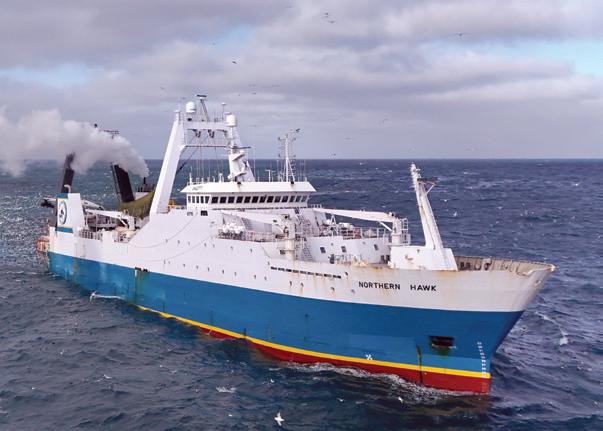
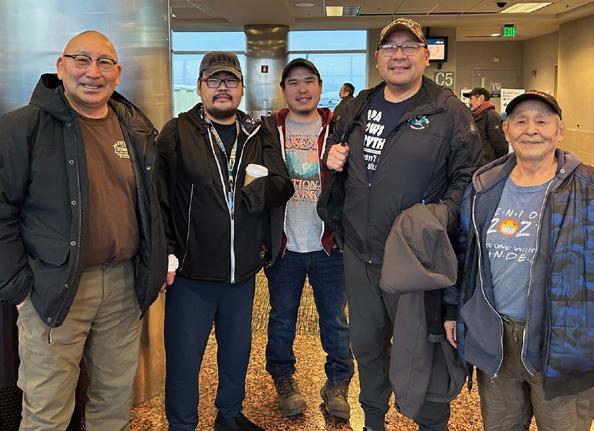
711
907-278-5151
1-888-795-5151
Website: www.coastalvillages.org
Facebook: facebook.com/CoastalVillagesRegionFund
Twitter: twitter.com/CoastalVillages
Instagram: instagram.com/CoastalVillages
YouTube: youtube.com/coastalvillages1
LinkedIn: linkedin.com/company/coastal-villages-region-fund
